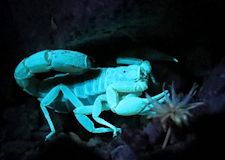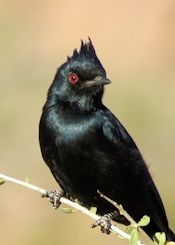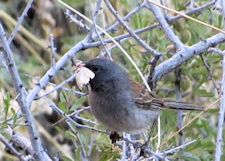
Elf Owl
The night before the "big day" I again camped out at Kofa Queen Canyon (Kofa NWR). An interesting non-avian sight was a young male desert male bighorn outfitted with a radio collar and two big ear tags--looking something like one of Santa's reindeers decked out with ornaments.
About 30 minutes after the sun set I heard my first COMMON POORWILLS of the season, and they kept calling, on and off, until dawn. Bob and I hadn't heard any the previous weekend during the NAMC.
A little exploring with a short-wave/black light turned up about half a dozen sand scorpions.
As I drifted off to sleep, I was serenaded by
ELF OWLS, WESTERN SCREECH-OWLS, and a distant GREAT HORNED OWL.

Sand Scorpion
The first passerine to greet the morning was an ASH-THROATED FLYCATCHER, who started up at 4:35 a.m.! By 5:00 a.m. I was hiking up Indian Wash, on my way to the Signal Peak saddle, listening to CANYON TOWHEE, CANYON WREN, SCOTT'S ORIOLE, and BLACK-THROATED SPARROW. Soon after I started my ascent of Ten Ewe Peak a loud whirring noise made me look skyward--two COMMON RAVENS were hurtling down the mountainside in a breakneck dive.

Phainopepla
It took them five seconds to cover the ground that had just taken me an hour to cover... Going around the "corner" of the ridge put me into the shaded upper canyon with lots of great brush and scrub tree habitat. Before long I heard faint chips and found a pair of BLACK-CHINNED SPARROWS carrying food to a nest. Flycatchers were well represented by PACIFIC-SLOPE, HAMMOND'S, and WESTERN WOOD PEWEE. A bit later I heard a RUFOUS-CROWNED SPARROW farther up-canyon.
Back down in Kofa Queen Canyon were dozens of TOWNSEND'S WARBLERS, flitting about from bush to bush. There were also a few YELLOW WARBLERS and just as last week, a solitary HERMIT WARBLER. Lots of VERDINS and PHAINOPEPLAS were calling.

Black-chinned Sparrow (with a moth)
Even though I'd meant to leave much earlier, I didn't get out of Kofa Queen until 10:00 a.m. Then I headed to the Dome Valley Feedlot, where ideal conditions meant lots of breeding BLACK-NECKED STILTS, migrating SPOTTED SANDPIPERS, and a good-sized flock of WHITE-FACED IBIS.